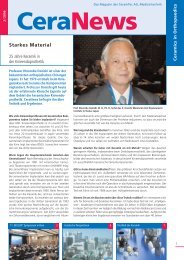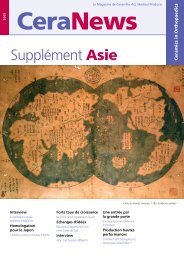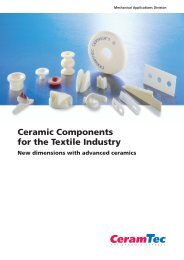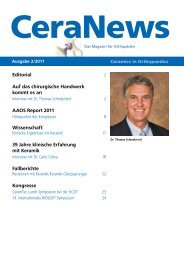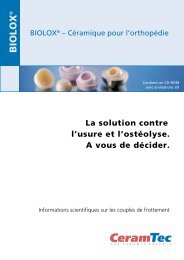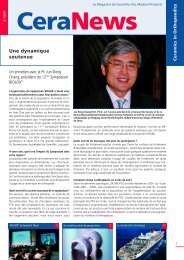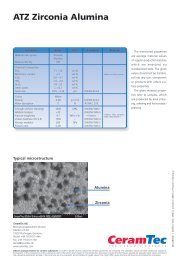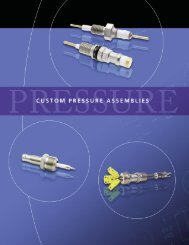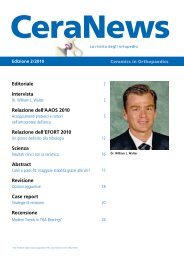Download PDF, 2.4 MB - CeramTec
Download PDF, 2.4 MB - CeramTec
Download PDF, 2.4 MB - CeramTec
Create successful ePaper yourself
Turn your PDF publications into a flip-book with our unique Google optimized e-Paper software.
10-year results with CoC THA due toosteonecrosis of the femoral headKyung-Hoi Koo (South Korea) pointed out thatosteonecrosis of the femoral head is the most commondiagnosis for hip replacement in Asia. Becauseit is mainly younger patients who are affected bythis condition, particular attention must be paid toimplant longevity. He reported on the initial resultsfrom his own study in which he followed up on 124BIOLOX ® delta CoC bearing couples (with a totalof 210 THA – 32mm, and 99 THA – 36mm). Therewere no fractures and no cases of squeaking over a16 month follow-up period. There were reports of 3dislocations and 2 cases of clicking noises.In his own personal experience, there is no perfectbearing couple, but the CoC articulation is the leastproblematic bearing.Ceramics seems to be the least bad articulation.- Kyung-Hoi Koo, PhDOther papersMoM hip resurfacing (MoM HR)At this year's EFORT Congress, much attentionwas devoted to hip resurfacing. There wasspirited discussion of findings with regard toclinical practice and fundamental research.Andrew G. Cobb (UK) and Thomas Poulsen (Denmark)reported on basics and the latest scientificfindings for MoM HR. Clinical outcomes in termsof quality of mobility, activity and longevity aregood. Revision rates have been cut from 13% to2% in recent years due to improvements in identifyingthe indication for HR and better implantationtechniques. The speakers mentioned tworecent groundbreaking publications. 1 Unfavorablepredictors included secondary osteoarthritis associatedwith dysplasia or osteonecrosis of the femoralhead, a small acetabulum, female gender and anage of over 65 years for men and over 55 years forwomen. In view of the known flat learning curve,the increased incidence of femoral neck fractures,and the increased metal wear in case of malpositioning,MoM HR should only be performed bysurgeons who are conversant with the procedure.Until the mechanisms behind ARMD are explainedthese implants will remain under close scrutiny. Inaddition, due to the fact that there are significantdifferences between the implants offered by variousmanufacturers, registry data should be trackedclosely.The correct positioning of components is a criticaldeterminant for ensuring optimal contact betweenbearing surfaces and lubrication conditions in orderto limit wear.The correct implant orientation will help to ensure thatwear occurs within the bearing surfaces, maintaining anoptimal lubrication regime and low wear.Darren Ebreo (UK) reported on a series of 22MoM HRs performed by one surgeon with an averagefollow-up of 3.2 (<strong>2.4</strong>–5) years. The average ageof the patients (12 male, 10 female) was 56 (44–69) years. In the group of 11 patients with a cupinclination of over 50° there was evidence of significantlyelevated serum chromium (146 nmol/L)and cobalt (245 nmol/L) ion levels versus the groupof 11 patients with a cup inclination of under 50°(92 nmol/L for chromium and 110 nmol/L forcobalt).It is precisely because high levels of metals in thebody have a toxic effect and could trigger immunologicalreactions, the effects of which remainindeterminate, that care must be taken to ensure asuitable inclination.- Azad Hussain, MDThere have thus far been few MoM HR studiesinvestigating implant orientation and itspotential impact on linear wear.Azad Hussain (UK) was analyzing the linear wearin relation to acetabular orientation (inclination oranteversion) in 70 MoM HR implants post retrieval.The acetabular cups which displayed morphologicalsigns of edge loading exhibited 20 times moremetal wear, with significantly increased cup inclination(54° vs. 45°) and anteversion (22° vs. 15°).Arne Borgwardt (Denmark) studied a randomizedgroup of 60 patients who had undergone cementlessCoC THA (alumina ceramic), had been given acementless MoM bearing couple (large diameter),or had undergone an MoM HR, for allergic reactivityfor up to 3 years after implantation. To thisend, elaborate serum level testing was performed todetect metal ions and immune response cytokines inthe body. Significantly higher metal ion levels weremeasured in patients with large diameter MoMimplants. One of these patients exhibited a hyper-1Corten K et al. Hip resurfacingarthroplasty: current status andfuture perspectives. Eur Cell Mater.2011;15(21):243–58Carrothers AD et al. Birmingham hipresurfacing: the prevalence of failure.J Bone Joint Surg [Br] 2010;92-B:1344–50.CeraNews 1/201213



